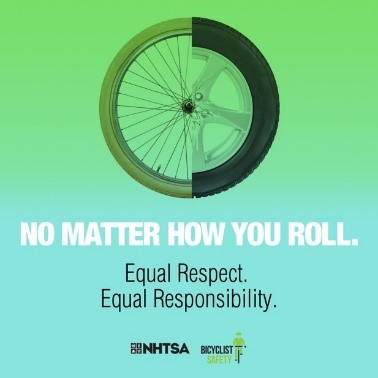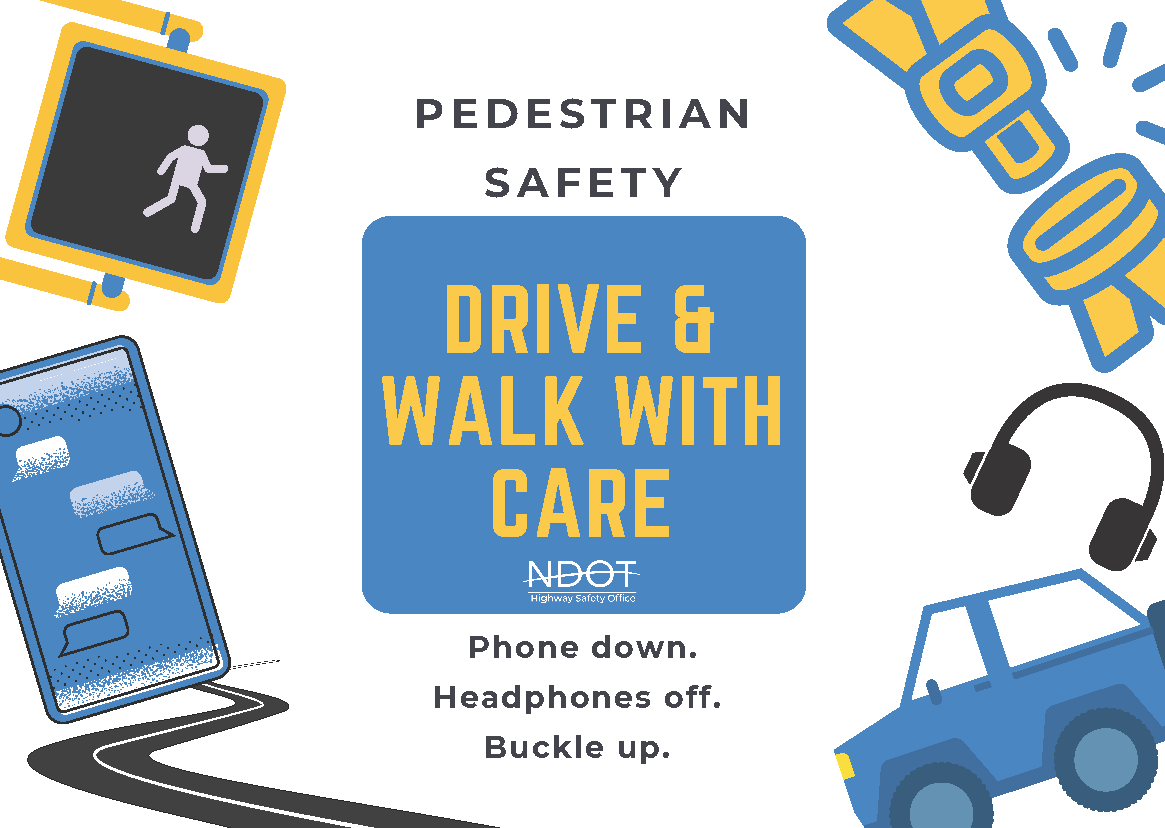- Expand Driving Safely
- Impaired Driving
- Child Passenger Safety
- Distracted Driving
- Drowsy Driving
- Motorcycle/Moped Driving Safety
- Expand Non-Motor Vehicle Safety: ATV, Bike, Pedestrian, & Train
- Seat Belt/Occupant Protection Safety
- Older Drivers
- Roundabouts
- Speed-Related Information
- Teen Drivers
- Work Zone Safety
- Winter Driving Safety
ATV Safety:
Nebraska’s All-Terrain Vehicle (ATV) Law
Bicycle Safety on the Road:
There are two main types of crashes: the most common (falls), and the most serious (the ones with cars). Regardless of the reason for the crash, prevention is the name of the game. There are things you can do to decrease your risk of a crash.
- Regardless of the season, bicyclist deaths occurred most often between 6 p.m. and 9 p.m.
- Bicyclist deaths occur most often in urban areas (75%) compared to rural areas (25%) in 2017.
- Bicyclist deaths were 8 times higher for males than females in 2017.
- Alcohol was involved in 37% of all fatal bicyclist crashes in 2017.
Remember, all states require bicyclists on the roadway to follow the same rules (laws) as those operating a motor vehicle. It’s your job to follow the rules of the road.
Best Practice When Riding:
- Ride a bike that fits you—if it’s too big, it’s harder to control the bike.
- Ride a bike that works—it really doesn’t matter how well you ride if the brakes don’t work.
- Wear equipment to protect yourself and to make you visible to oncoming traffic, a good fitting bike helmet, bright clothing (day or night), reflective gear, and a white front light and red rear light and reflectors on your bike. This safety gear could save your life.
- Tuck and tie your shoelaces and pant legs so they don’t get caught in your bike chain.
- Plan your route—if driving as a vehicle on the road, choose routes with less traffic and slower speeds. Your safest route may be away from traffic altogether, in a bike lane or on a bike path
Stay Focused While Riding:
Be focused and alert to the road and all traffic around you; anticipate what others may do, before they do it. It is important to be on the defense when riding—the quicker you notice a potential conflict, the quicker you can act to avoid a potential crash.
- Drive with the flow, in the same direction as traffic.
- Obey street signs, signals, and road markings, just like a car.
- Assume the other person doesn’t see you; look ahead for hazards or situations to avoid that may cause you to fall, like toys, pebbles, potholes, grates, train tracks.
- No texting, listening to loud music or using devices that distract you by taking your eyes and ears off the road.

Pedestrian Safety Reminders:
Pedestrian fatalities have risen since2016 and currently hover around 20 deaths a year and approximately 400 injuries annually.
At one time or another we are all a pedestrian, so whether you are a concerned parent, caregiver, or seeking a great way to stay healthy and be part of your community by walking; it is important to make sure pedestrians of all ages use safety precautions while enjoying the benefits of walking.
Safety Tips When Walking:
- Follow the rules of the road and obey signs and signals.
- Walk on sidewalks whenever they are available or use a trail if available.
- If there is no sidewalk, walk facing traffic and as far from traffic as possible.
- Always keep alert; don’t be distracted by electronic devices that take your eyes (and ears) off the road.
- Cross streets at crosswalks or intersections, where drivers expect pedestrians. Look for cars in all directions, including those turning left or right.
- Never assume a driver sees you. Make eye contact with drivers as they approach to make sure you are seen.
- Be visible always. Wear bright clothing during the day and wear reflective materials and use a flashlight at night.
- Watch for cars entering or exiting driveways or backing up in parking lots.
- Watch for uneven surfaces, be sure to pick your feet up and use a walking stick if you need extra support.

Train Safety:
- Freight trains don't travel at fixed times, and schedules for passenger trains often change. Always expect a train at each highway-rail intersection at any time.
- It takes the average freight train traveling at 55 mph more than a mile—the length of 18 football fields—to stop. Trains cannot stop quickly enough to avoid a collision.
- The average locomotive weighs about 400,000 pounds or 200 tons. This makes the weight ratio of a car to a train proportional to that of a soda can to a car. We all know what happens to a soda can when it is hit by a car.
- A train can extend three feet or more beyond the steel rail, side-to-side. The safety zone for pedestrians is well beyond the three-foot mark.
- Today's trains are quieter than ever, producing no telltale "clackety-clack." Any approaching train is always closer, moving faster, than you think.
- Remember to cross train tracks ONLY at designated pedestrian or roadway crossings and obey all warning signs and signals posted there.
- All train tracks are private property. Never walk on tracks; it's illegal trespass and highly dangerous.
- Stay alert around railroad tracks. Refrain from texting, using headphones or other distractions that would prevent you from hearing an approaching train.
- Trains have the right of way 100% of the time.
For More information on Train Safety visit Operation Lifesaver

Resources:
National Highway Safety Administration, Bicycle Safety.
U.S. Consumer Product Safety Commission, ATV Safety Report
Pedestrian Safety and Laws, UNL
Operation Lifesaver, Rail Safety Education
Safe Kids Worldwide, Safety Tips
CDC, Pedestrian Safety
Nebraska Game & Parks, Trails
Rails to Trails, Nebraska
Bike Walk Nebraska, Non-profit
